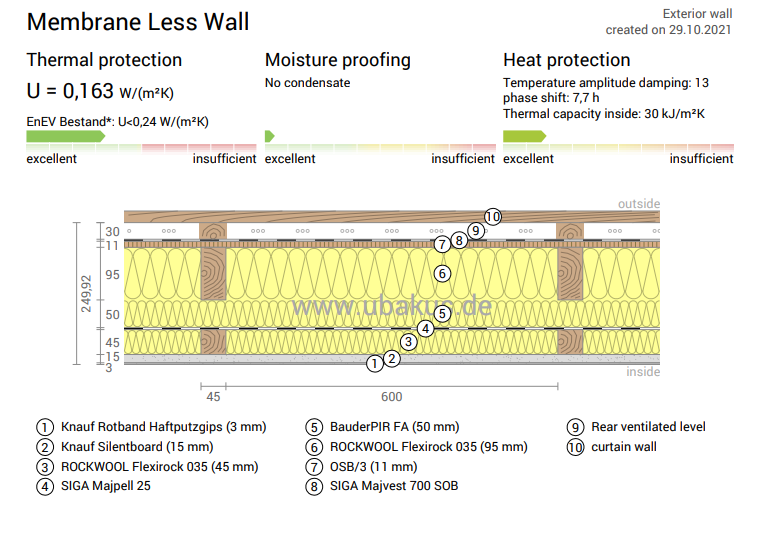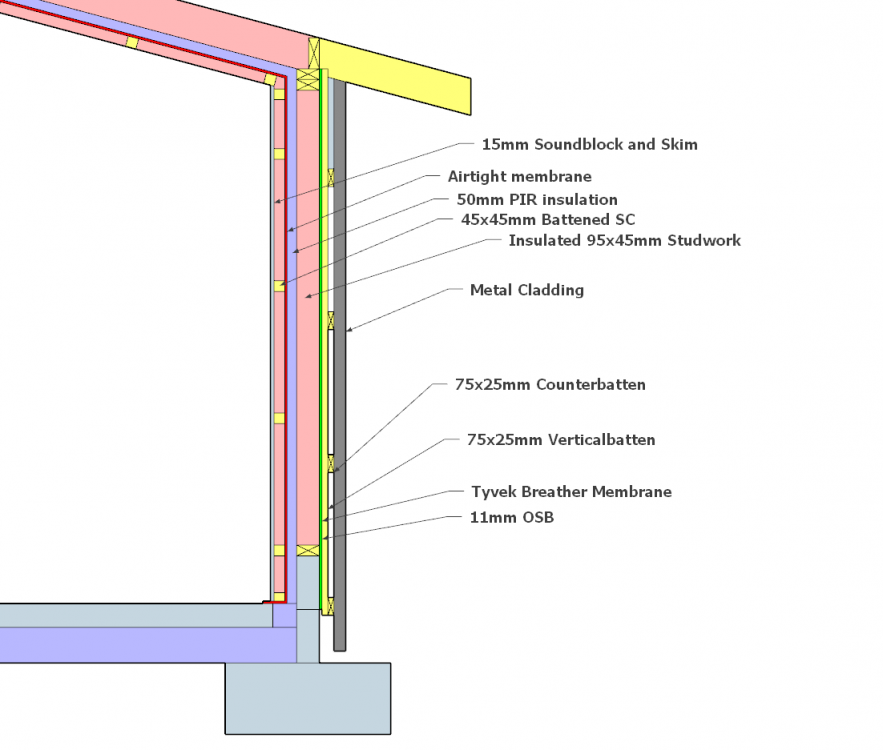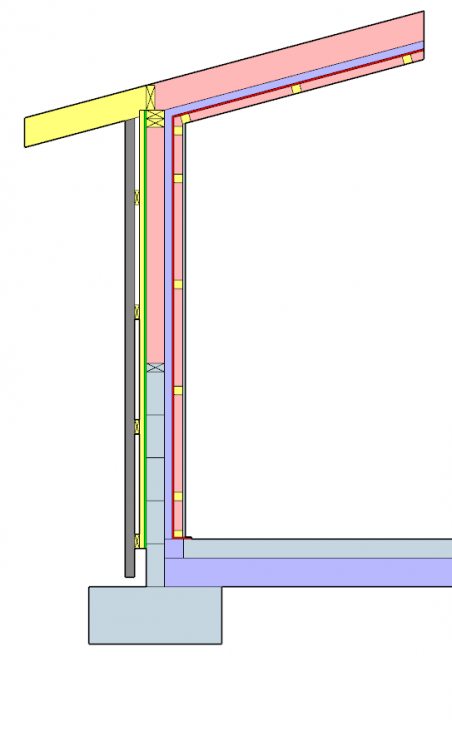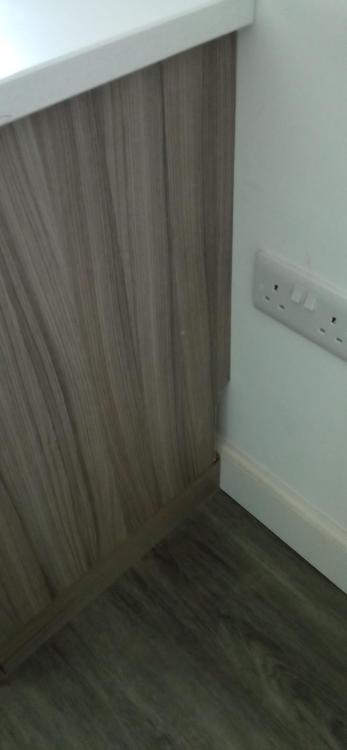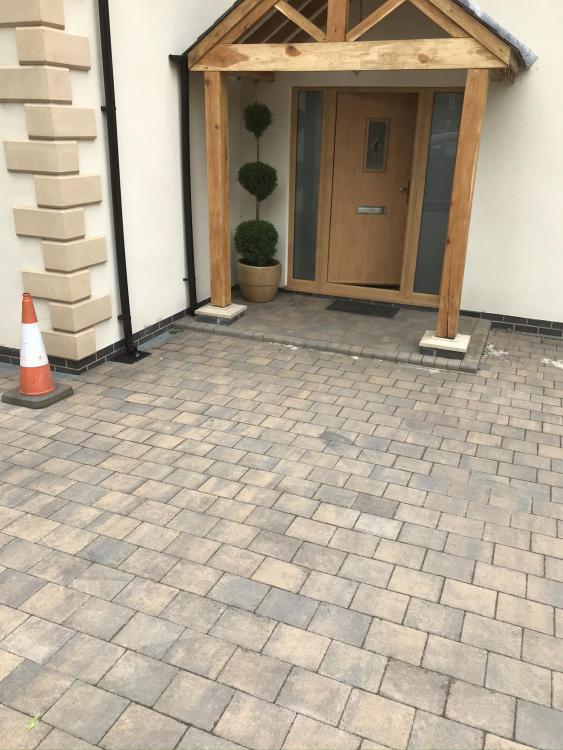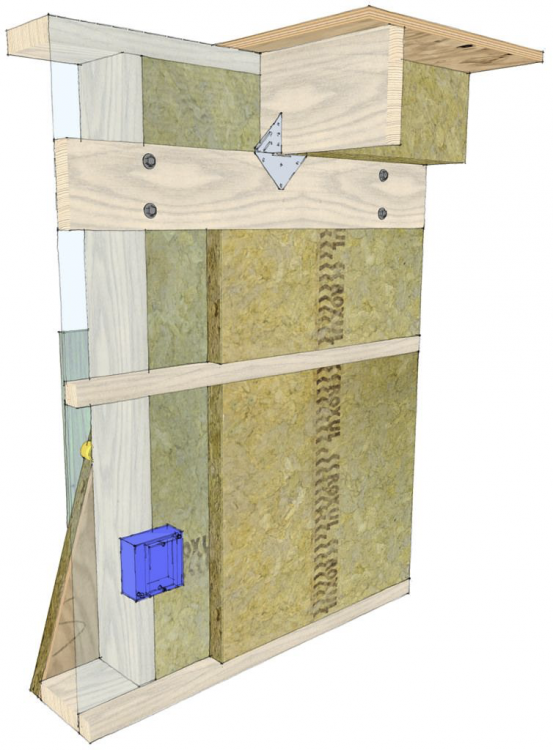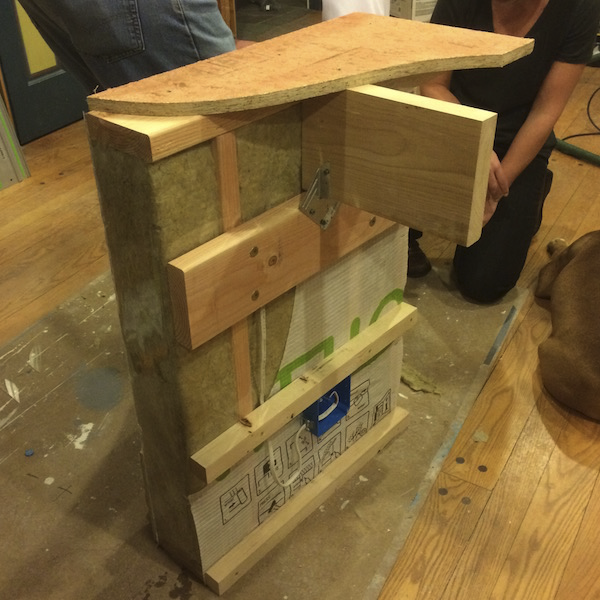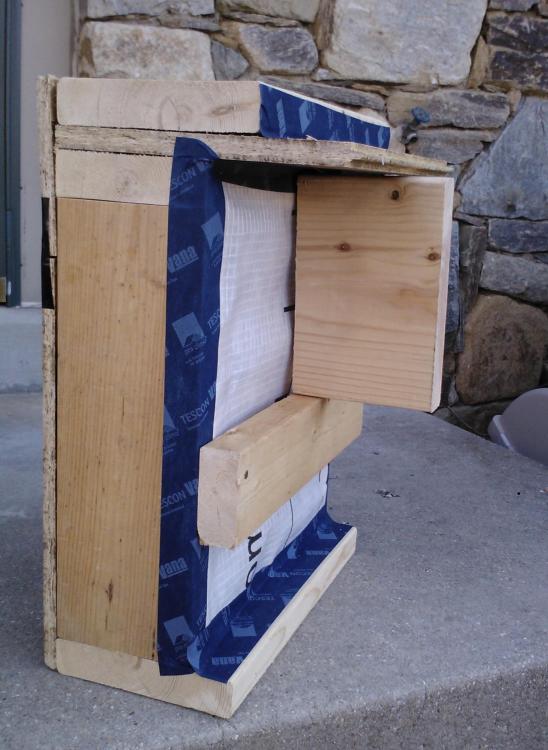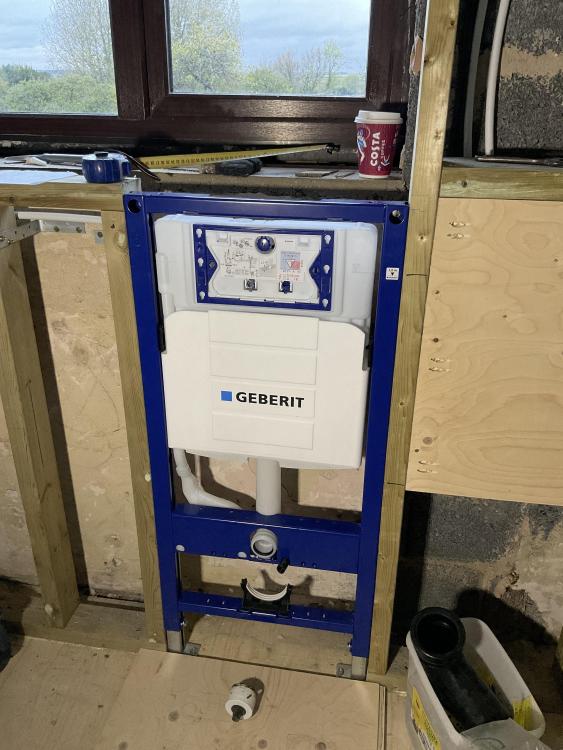Leaderboard
Popular Content
Showing content with the highest reputation on 10/29/21 in all areas
-
2 points
-
Thanks for getting back to me. I've had a think. Firstly winter is coming. You need to get this closed in as quickly as possible. If cost is a priority I'd forget double framing. Timber and sheet materials are gone far too expensive. It was pioneered in the States where they get extremely cold and prolonged winters and lumber is (was?) cheap. Neither are true at the moment in our fair isles. It might seem like a kick in the teeth but I think you are better off knocking down the 2 courses of external blockwork and getting on with your external cladding. I would also take down the internal studwall being built. My proposed build up is as follows. 15mm Soundblock plasterboard + Skim 45x45mm battened service cavity @600cc insulated with 50mm Frametherm 35 or similar. Airtightness membrane. 50mm PIR. 95x45mm structural stud with 100mm Frametherm 35 insulation. 11mm OSB sheathing, Tyvek breather membrane. 75x25mm treated vertical batten. 75x25mm treated counter batten. You could increase the PIR layer if you're really chasing U values but 0.16 is more than adequate I wager. If PIR is too dear you could omit this but it will really help with the 4ft section of block wall to bring that up to a good level of insulation. by forming a continuous layer of it you would really minimise any thermal bridges with the existing structure. Nothing to stop you using seconds for the PIR. However I would be slow to go above 50mm+45mm service cavity as screws get expensive above 150mm. https://www.secondsandco.co.uk/product-page/50-55mm-kingspan-non-foil-1-2-x-2-4 I reckon that it'll be £18/m2 less and a lot less labour. I'll have a look at the roof if I get a chance tomorrow however a quick google suggests it is a very expensive way of purchasing insulation. Are you absolutely totally committed to this thickness?2 points
-
+1. Mines never been cleaned. Can changes can be a bit messy, but let any excess go off then scrape it off. Same with the nozzle; a quick scrape with a Stanley knife blade before use and all's good!2 points
-
Craig.. thanks for your post.. every day is a school day re first floor windows. Being Scottish based most of the burglers are too incapacitated to reach the first floor! it's the Buckfast effect. For all Uk wide just make sure you have covered the regs regarding fire escape, it's easy to get caught out here in the excitement of you new home.1 point
-
Here’s the bottom line. Not all of your windows and doors on the ground floor must be laminated. Pas24:2012 which has been superseded by 2016 but both are accepted but SBD are no longer accepting 2012. What does it mean? Ground floor windows should be Pas24 but only if your window is within 400mm of a door, should it be laminated. Otherwise toughened glass is fine. Doors should be Pas24. First floor windows is different, that is down to whether they are easily accessible or not.1 point
-
1 point
-
1 point
-
If this blue mould lives off the free sugars in the timber, maybe a blast over with a blow torch, which will combust the sugars, will permanently sort the problem. See what I did there, I got burning back into the processes.1 point
-
It was a choice of; 1) read that 2) order another bottle of Shipyard hic…..1 point
-
Yeah. Need a VCL over insulation. That’s why I’d suggest DPM/radon on top. To act as VCL and keep concrete slurry from going in between imperfections in insulation.1 point
-
As a result of it being on the front of the dwelling, you cannot raise (or alter) the roof via PD. So your only option is to meet the LPA’s policies and concerns. Could you not get a lean-to pitched roof to work as the LPA should be more favourable towards that as opposed to a raised flat top?1 point
-
The lovely joiner guy plus me and the wife! Who knew the joiner does a lot of weight training ??1 point
-
not something I've looked in to and just don't have the budget for it at the moment! I'm hoping that our 10kWp array will produce enough electricity on the good (and maybe some not so good) days that we can drastically reduce our reliance on the grid and simply pay the higher cost of buying from the grid if and when we require it.1 point
-
not installed as the superstructure is still going up. but it's almost all paid for. we've decided to get a single phase inverter rather than 3-phase inverter even though we will have a 3-phase electricity supply. the house is only going to be run off a single phase and this way ALL of the generated electricity can be used to run the house and charge the battery and then excess can be exported. the research I did revealed that net metering and 3-phase smart meters are hard to come by at the moment and I just didn't fancy the extra complexity of exporting 2 phases and then importing on the single phase especially when our application to the DNO for a 10kW export was accepted. so, long story short, only 1 battery required on a single phase inverter for us. I think this is one competition you will win.1 point
-
1 point
-
Here it is, less than £1700 all in with the quartz worktops, wardrobes and fitting. Only minor gripe is that as our dressing table was in a slightly different place than it was originally fitted and connected to things and as we don't have it connected to anything you can see where the skirting was cut and in hindsight we should have had the worktop longer so the joiner could have put an end piece on. There will be a standing mirror there so you won't see it and perhaps we can think of something to put there to cover it. Needless to say we are putting clothes into something not made of cardboard tonight ? VID_20211029_165849.mp41 point
-
Oh, sorry, bought a paper copy and it's in Bricks & Mortar section. https://www.thetimes.co.uk/article/my-heat-pump-cost-me-thousands-and-no-one-will-repair-it-w7ps6n57n & https://www.thetimes.co.uk/article/house-of-the-week-britains-first-off-the-shelf-eco-house-that-can-actually-earn-you-money-hvbz9gkzv1 point
-
I have to say I have some sympathy for this perspective. One of the biggest concerns I have right now is that a small number of extremely rich technocrats, like Bill Gates, are going to take it upon themselves to intervene using geo-enginering when they actually understand very little, and cannot in any way predict, its effects on a global scale. The fact that some people are taking this approach seriously is just bonkers. I mean, would you really trust the global climate to the guy responsible for Windows? For me another problem is that very few understand the extend to which things have to change to reach the current goals and to do that while maintaining the holy grail of exponential GDP growth is a sign that the current crop of policy makers have their heads stuck somewhere rather dark. From another perspective entirely, there are number of environmental scientists who are not bought into the hysteria but have a more moderate view based on the planet's complex self-organising behaviour. I've only seen a small handful of those published and maybe right now they're pressured into remaining largely silent. A lot of the fear is because we simply don't know what's going to happen and cannot actually predict it, despite the rhetoric. Frankly, we don't know if the changes to our climate might self-organise in a way that subsequently cools the planet down, or not, or the timescales involved, and we don't have either the tools or knowledge to model these effects. We already know there are serious problems with existing models because from a systems perspective, they have failed to predict that some climate change patterns will accelerate faster as the existing system adapts - yet from a system theory perspective this type of acceleration within a reorganising system is already understood to happen. As I think I may have said in another thread, I think what is going on is serious but I think the hysteria is the wrong way to approach it and will often lead to detrimental short-term knee-jerk reactions. I actually think the idea of replacing all the UK's and possibly the world's boilers with a/w heatpumps is up there with those.1 point
-
1 point
-
1 point
-
There is reliable information on this in the HSE documentation, ie saying that the risk is very low. if still concerned, reply and I will find it. Have taken these tiles up many-a-time and it is a normal contractor job, not even specialist. To be dangerous you would have to grind these tiles up to expose the fibres (2% of the total volume) then breathe it in. I don't expect you have done that. Relax.1 point
-
1 point
-
Just picked up on this thread. I had the same question as I needed foundation pads under an existing wall. One party wanted to call it underpinning so warranty provider wanted licensed contractor etc. I asked the SE to clarify in the drawings it was for strengthening and providing new foundations for steel frame. Everyone relaxed then. It's all down to a simple word! I dug it all out and filled myself according to the structural design. BCO/Warranty inspector was totally relaxed about it following pre pour inspection.1 point
-
There are special pavers that are shaped to leave a 3mm gap between. The system requires special fines free sub base and pointing with a kind of grit. All very expensive. If your BC accepts normal kiln dried jointing sand then that will be good, although not permeable / SUDS compliant. https://www.marshalls.co.uk/commercial/permeable-paving-and-suds1 point
-
If the joints are sanded rather than pointed Water will soak right through BC will be fine with that1 point
-
I have been rumbled. I did not believe what I wrote, my intention was to illustrate the viewpoint of an IB protester. One response above did expose the complacency of those who subscribe to climate change alarmism as a fashion statement but don't want to be truly inconvenienced. Those who subscribe to climate alarmism must by definition believe the world will be a horrible place by the end of the century given current climatic trends, we are talking about 1930's dust-bowl america on a global scale. The world population has risen 3 fold since the 1930s and it is unlikely a dust bowl Earth could support 7.2 billion humans in the year 2100. In this context we are predicting a world where 10s or 100s of millions or even a billion humans have met an untimely end to their lives by 2100. If so IB actions to effect urgent change are reasonable and rational. I actually think the world community is making impressive changes to de-carbonize and we will get to net zero within 80 years. By that time ppm will be 500 and the climate will be exhibiting a few minor reactions to high co2, some beneficial and some negative. What concerns me with the current over hyped hysteria re. climate change is that when we try but fail to reduce co2 emissions within 10 years and the climate continues to skip merrily along, people will reject the whole premise of co2 reduction. A counter culture might develop as people across the globe reject the economic hardships of an authoritarian panic response to climate change. In a scenario of rising co2, economic hardship and a pleasant climate the whole net zero mission might be shelved as a discredited early 21st century scientific snake-oil.1 point
-
Hi, this comes up many times, loads of tiles and sheets contain asbestos but the likelihood of this kind of exposure causing any harm is very low. loose fibrous asbestosis a different story. Search previous threads for similar content for re assurance1 point
-
The only time you need to double up sole and top plates is when studs and rafters don't line up. + 1 to that. Don't add any osb until you've got at least some cover from the roof. I wouldn't brace until it's upright as it can then be trued up in all directions. As for 9 or 11mm it would typiclly depend on what the SE specifies. Same for the the roof. And to risk being picky, you'll either be building using 38 x 140 cls (50 x 150 unfinished) or 47 x 150 (45 x 145 nominal finished) carcassing, these differences will make a difference to your frame and subsequent dimensions. The cls can be ideal because you can get it at 2.7m lengths too. . That's very neat. Still lots of stick framing going on in Sweden mind you, it's seen more as the diy route nowadays but it's understandable given the climate why they like to go indoors to make their houses. I'm still bemused why there isn't more in the UK. Instead there seems around us to be a massive growth in the use of tin hat scaffolds at major cost to the customer. I have a slight hybrid of the framing method where I have a glulam ring beam and my 1st floor joists hang off that rather than penetrating througth the tf.1 point
-
Speaks the voice of wisdom and experience on all bedroom matters. Off to the woods now.1 point
-
This sounds like a very wise move. We'll be sure to phrase things carefully, comitting to build using passive house techniques rather than specifically to achieve certification.1 point
-
Use 18 mm for making structural box beams? 9/10/11/12 mm is PLENTY for sheathing to give shear resistance. It's also walkable on 600 centres for the purposes of adding insulation / putting on a roof etch as long as you're not a particularly fat bastard or jumping up and down etc. For headers...I would do this next time: https://bygghouse.com/wp-content/uploads/2017/02/Summary-of-Swedish-Wall-Element-Construction.pdf http://blog.lamidesign.com/p/swedish-platform-framing-info.html (single header, bring the wall studs all the way up to the level with the floor, then put your "second header" vertically against the inside of the wall to carry the floor load - after you've lapped your airtightness membrane over the top of the header ready to sandwich it under the floorboard. Tape the bottom piece of airtightness membrane down onto the floorboards before you build the next level of wall on top. It'll then be squashed down by the sol plate of the floor above. Roof trusses can be treated the same way. Those little diamond tiedowns pick up the roof truss at the top, then the header on the two side ears, and (if aligned) the wall stud on the bottom ear...but from the outside not from the inside. so that there's nothing to interrupt your airtightness membrane...that you remembered to lap over the top of the header, taped to the existing wall membrane, before you sat the trusses on top of it. Use some little tiling battens to squash the taped joint flat for extra security if you like.1 point
-
@James94 so there’s the screws in through the feet, and then I used to hex washer heads which screw through the frame into the timber. These are located just beneath cistern. There’s also a location for another 2 screws right at the top of the frame on either side however these are difficult to get to from the inside, but it’s rock solid as it is. Water inlet and waste are pretty self explanatory. You’ll breeze through installing it.1 point
-
I don't think smackheads really care about getting caught, they are just after easy to lift and sell stuff. And cars.1 point
-
@Smallholder why not aim for EnerPhit rather than full Passiv..? As @SteamyTea said, you will struggle with air tightness on straw with lime plasters etc, so will end up with internal membranes such as Intello so you’ll start to lose some of the ethos of why use bales IMHO.1 point
-
No. Part of the Passivhaus standard, if you want to get a certificate, is that they specify all sorts of things, like washing machines, that meet their criteria. (Ecolabel) This is why many people do not bother with certification. There is also the airtightness, which may prove difficult to achieve with a structural straw bail build, it is hard enough to achieve with cast concrete.1 point
-
A few years ago there was a spate of cars being stolen around our old house. People broke a door lock and came into our kitchen, but the alarm went off and scared them away, so a small piece of anecdotal evidence there. On the other hand, neighbours across the street were on holiday and people broke in. It took them less than two minutes to silence the alarm, search the house for their car keys and drive off. I caught it all on our Ring camera, but could only see what was happening and not identify anything specific. Discussion with neighbours then ensued. Everyone wanted a high tech and expensive wa to protect their cars. This was ridiculous in my view. The best way to stop burglaries is physical protection. If they cannot get in or see anything worth stealing they will move on. Certainly here, mos burglaries are to get car keys and the simple solution is to put you car in the garage. We have been doing this every day for years now and had no further issues. I just could not persuade people to do this instead of spending money on more exciting, but less useful high tech solutions. Maybe it is best to think about how to increase security and what gives the best cost benefit. 1. Physical security - Locks - After our french door lock was broken, I was surprised to find that an enormous percentage of burglaries involve lock snapping as had ours. We replaced all our locks with higher quality locks where this could not happen easily. This cost just a few pounds per lock and the mind boggles that window companies and builders do not fit these as standard as the extra cost on new doors and windows would only be a few pounds. A total no brainer. Laminated glass - Again, a very high percentage of burglaries involve broken windows. My parents were broken into by simply chucking a brick through their patio doors. All of our windows are laminated. I consider this one of the best ways to prevent burglary. It would be quite hard to get into my house or already replacing windows. Great if building a new house, too expensive otherwise. You can add film to existing windows to the same effect, but this is not that easy. Lights - The data you attached suggests that security lights are a cheap no brainer. LED lights now mean that you can light up your house quite cheaply and easily at night. We have dawn to dusk lights on permanently. They can also make it look like you are at home, up early etc. Again, a cheap no brainer. Secure your car - Garage, bollards, gates etc. A decent percentage brurglaries are to get your car keys. If you car is in the garage or behind bollards or a gate then they will move on to an easier target. It could well be free to put your car away, it also stops it frosting over, keeps it cleaner etc. Total no brainer. 2. Alarms These probably are of minor deterrent use, but the key thing is do people actually use them. We had our alarm on when broken into and it scared them off. Today our alarm is app connected and very easy to set from in bed our when out/ on holiday etc. I can turn it off when on holiday if someone wants to check the house then back on. I feel that using the alarm is key and that the right kind of system today makes using the alarm much easier. Monitoring etc need not be expensive. We have a wireless system, professionally installed. The lack of cabling makes the install match cheaper. Monitoring and servicing costs £250 a year. You get part of this back in reduced insurance. However, I would say that monitoring is only useful when not at home and the main deterrent factor is that the alarm wakes you up and scares off burglars. The reason I think insurance companies like to see you pay for this is that it tells them the alarm works and you use it. People are more often than not at home when burgled. 3. Cameras. I have CCTV cameras, but I am very skeptical of their worth. The reason for this is that most burglaries occur when it is dark and that you cannot identify people in the dark on a camera. Similarly all it requires is putting on a big hood to cover your face. I have them so that I can monitor what is going on around the house and for a bit of a deterrent, but I consider other things much better security. I think a Ring type doorbell camera is probably better than CCTV as a lot of people will try your front door to see if anyone is home and to see if it is left open. 4. Don't be overly flash with easy to steal stuff. Much as this smacks of victim blaming. Putting loads of expensive stuff on display is very tempting. Again the evidence you posted shows that burglars look at risk/reward. What do most people have of value in their house that could be easily stolen nowadays. TVs have collapsed in value. Maybe laptops. Jewellery, watches, cash etc are much higher value small items. If you show off these things it increases the chance of being targeted. Similarly if you have an expensive car, put it in the garage. Why would you break in to a house to steal a car when you don't know if it is even there. You car is likely worth multiple times anythignthat could be stolen from in the house. In smart many kinds of physical security cost next to nothing to massively reduce your chances of being broken into. Not flashing your wad of cash and wearing your Rolex everywhere would also help, but is probably not relevant to most people. After this cameras and alarms are more expensive with less incremental improvement, but the combination of multiple approaches will likely make you safer. To me an alarm is relatively cheap compared to the hassle and distress of being burgled.1 point
-
I was referring to the first detail with suspended floor slab. Most recent details show ground bearing slab. IMO I’d place DPM /radon barrier on top of insulation under screed/slab but it’s a matter of preference TBH. But if GL high I would wrap DPM up inner block. This detail falls down at doors and maybe overkill. As long as cavity ending is 9” below DPM level DPC it’s not necessary to wrap. I’d also leave outside block work perpends at cavity ending open for drainage, all in all the most recent details are excellent1 point
-
Not great. MVHR is a good for ventilation, not much else. Shades only work on southern elevations really due to the low sun angle east/west.1 point
-
I only heat our DHW to 48 degrees. That temperature found by experiment to be the absolute hottest I can hold my hands under without being painful. I can see no need for DHW being hotter than that. The use of the immersion heater is probably because it is working hard to do the DHW heating and the worst ambient temperature for an ASHP is a few degrees above 0 when it is most likely to ice up and need defrosting. It probably senses the icing issue and switches to the immersion instead. Just lowering your target DHW temperature will reduce that, but you will probably be able to disable the use of the immersion in some settings if you really wanted to. The buzzing box is a contactor. they shouldn't make that much noise, you have a bad one. It's unlikely to be dangerous, just annoying. You could complain to the supplier and get them to swap it and hope the next one is less noisy. Many of us concluded that if you have mains treated water and an unvented water cylinder there is no need to a legionairs cycle so we have turned that function off. Once it gets well below 0 icing ceases to be a problem as there is little moisture left in the air.1 point
-
personally, I disconnected the immersion from the FTC6 and hooked it up to my own SSR solar PV diverter instead. I had to dig around in menus and the dip switches to stop the FTC trying to power the immersion all the time as you say anyway, as the contactor in it makes an absolute din of a buzz which could be heard right across the house. I have the FTC6 DHW set to 48ºC target, and also use the "smart grid" input on it when we have 4kW of excess solar available, or guests staying over, which causes it to boost the target up to 56ºC, which it can reach fine on its own even without the immersion. Caveat: I live in mild Herts so haven't stressed test this with colder outdoor temperatures yet.1 point
-
Lol, great response. Your Auntie Rene has developed, over time, a hardiness which has got her to 94! Fantastic.1 point
-
To be fair, I think the house should be condemned. It’s about to go up for sale, and I think only a fool would buy it. The cottages were built for mine workers by the Duke of Bedford in the 1860s, out of the rubble dug from the nearby mines. A sort of philanthropy on the cheap. As the doors and windows have been perpetually closed since February, and there’s been no heating on, the whole place has a sheen on mildew - every carpet and wall - and the black mould is even worse than before. It’s an absolute health hazard. That said, Auntie Rene is still going strong at 94 (now in a care home) having lived in those conditions for over 55 years. Maybe it’s possible to acquire a health benefit from living in such an environment…1 point
-
The name your looking for is Abacus and the general consensus here I believe is that it's w**k! ? I believe they pretty much copied Geberit, might even have been some legal proceedings instigated.1 point
-
0 points
-
Have seen it happen...lucky I arrived to save the day. The usual problem of too much water in the mix. It pushed down again. sealing the joints or polythene over is such a good and simple thing.0 points
-
0 points
-
0 points
-
@MarcoP87, I’m sure your question is serious and I’m sure there will be some constructive suggestions along shortly, for now … enjoy the innuendos0 points
-
0 points
-
Opened up for me. Was worried that it may be a Pandora's Box. But sounds more like something from her friend Ann Summers. Have you left an multitool in the cavity.0 points



